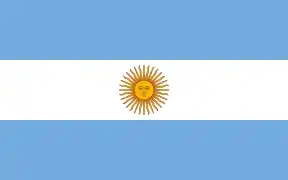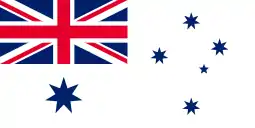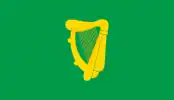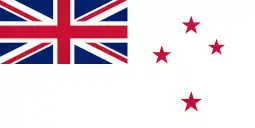Ton-class minesweeper
The Ton class were coastal minesweepers built in the 1950s for the Royal Navy, but also used by other navies such as the South African Navy and the Royal Australian Navy. They were intended to meet the threat of seabed mines laid in shallow coastal waters, rivers, ports and harbours, a task for which the existing ocean-going minesweepers of the Algerine-class were not suited.
 Silhouette of a Ton-class minesweeper | |
| Class overview | |
|---|---|
| Name | Ton class |
| Builders | John I. Thornycroft & Company, Southampton |
| Operators | |
| Preceded by | Algerine class |
| Succeeded by | River class, Hunt class, Sandown class |
| In service | 1951–1994 (Royal Navy) |
| Completed | 119 |
| Active | 1 (Malaysia) |
| Preserved | |
| General characteristics | |
| Type | Minesweeper |
| Displacement | 440 long tons (447 t) |
| Length | 152 ft (46 m) |
| Beam | 28 ft (8.5 m) |
| Draught | 8 ft (2.4 m) |
| Propulsion | Originally Mirrlees diesel, later Napier Deltic, producing 3,000 shp (2,200 kW) on each of two shafts |
| Speed | 15 knots (28 km/h) |
| Complement | 33 |
| Armament |
|
.jpg.webp)
Description
The design of the class drew on lessons learnt in the Second World War when it became apparent that minelaying in coastal waters was more effective than in the deep sea; the existing fleet minesweepers were not well suited to deal with this threat. Design started at the Naval Construction Department in Bath in 1947 and the first ship was ordered in September 1950; the class eventually numbered 119 vessels. The lead constructor was John I. Thornycroft & Company, although Ton-class vessels were also built at fifteen other yards.[1] They were diesel powered vessels of 440 tons displacement fully laden, largely constructed from aluminium and other non-ferromagnetic materials, with a hull composed of a double layer of mahogany planking. Their small displacement and shallow draft gave them some protection against pressure and contact mines and allowed them to navigate in shallow inshore waters. Primary armament was one Bofors 40 mm gun, although the South African variants also had an Oerlikon 20 mm cannon behind the funnel. RN vessels also had the same but they were gradually removed and an M2 Browning machine gun mounted midships. Sweeping equipment was provided for moored mines and magnetic mines.
It was originally planned to name the ships after insects, with names like Red Ant, Green Cockchafer and so on, but this plan was abandoned in 1952 and the Royal Navy ships of the class were given names of British towns and villages ending in "-ton", hence the name of the class. The contemporary but smaller inshore minesweepers were originally to be named after birds, but became the Ham-class, after towns and villages ending in "-ham".[1]
Sixteen of the class were converted to minehunters[1] by the incorporation of active rudders and the installation of the Type 193 minehunting sonar and associated equipment, including a very welcome enclosed bridge (the exception being HMS Highburton which retained her open bridge until decommissioning in the 1970s, this actually becoming a source of manliness to her crew when meeting other Ton crews). These vessels only retained mechanical "Oropesa" sweep capability.
The Ton-class served as patrol vessels in Borneo, Malaysia, Northern Ireland and Hong Kong. The minehunters played a significant role in the Suez Canal clearance after the Yom Kippur war. They also provided the backbone of the UK's Fishery Protection Squadron (4th MCM).
With the rundown of the Royal Navy fleet in the 1960s, many were sent to become base ships for the Royal Naval Reserve allowing reserve crews to get to sea for short periods without a lot of effort to organise a crew of significant size. Some of these had their names changed to reflect the RNR Division they were attached to. Five of the class in Royal Navy service were permanently converted to patrol craft for service policing of Hong Kong's territorial waters in 1971. These vessels, comprising HM Ships Beachampton, Monkton, Wasperton, Wolverton and Yarnton had their minesweeping gear removed and were fitted with a second Bofors 40 mm gun aft of the funnel. They also received new pennant numbers: Beachampton P1007, Monkton P1055, Wasperton P1089, Wolverton P1093 and Yarnton P1096.[2] Two vessels were converted into survey ships, one an air sea rescue vessel and one a diving tender.[1]
At the start of the Falklands War in 1982, the elderly Ton-class vessels were deemed to be unsuited to the long voyage to the South Atlantic, so five deep-sea trawlers were hired and hastily converted into minesweepers, although the crews were largely taken from the Ton-class mine countermeasures flotilla based at Rosyth.[3]
The RNR vessels lasted until the introduction of the River-class minesweepers in 1984. The remainder of the regular RN ships began to be retired with the introduction of the Hunt-class MCM vessels from 1980. The last RN Ton-class ship to be withdrawn was also the last to have been built; HMS Wilton (M1116) had been built in 1971 - 1972 with a hull made of glass reinforced plastic (GRP) instead of wood. She was the first major warship in the world using this technology, which was used for all of the succeeding Hunt-class ships. Decommissioned in 1994, Wilton became a floating clubhouse for the Essex Yacht Club at Leigh-on-Sea.[4]
Ships
Royal Navy
The Royal Navy of the United Kingdom received 115 Ton-class minesweepers during the 1950s. Several were later sold or transferred to other countries.

| Ship name | Pennant | Launched | Fate |
|---|---|---|---|
| Alcaston | M1102 | 5 January 1953 | sold to Australia in 1961, renamed HMAS Snipe, broken up in 1985 |
| Aldington | M1171 | 15 September 1955 | sold to Ghana in 1964, renamed Ejura, broken up in 1979 |
| Alfriston | M1103 | 29 April 1953 | broken up in 1988 |
| Alverton | M1104 | 18 November 1953 | sold to Ireland in 1971, renamed LÉ Banba, broken up in Spain in 1984 |
| Amerton | M1105 | 16 March 1953 | broken up in 1971 |
| Appleton | M1106 | 4 September 1953 | broken up in 1972 |
| Ashton (ex-Cheriton) | M1198 | 5 September 1956 | broken up in 1977 |
| Badminton | M1149 | 14 October 1954 | broken up in 1970 |
| Beachampton | M1107 | 29 June 1953 | converted to Hong Kong Patrol craft 1971 and pennant number changed to P1007, broken up in 1985 |
| Belton | M1199 | 3 October 1955 | broken up in 1974 |
| Bevington | M1108 | 17 March 1953 | sold to Argentina in 1968, renamed Tierra del Fuego, broken up in 1995 |
| Bickington | M1109 | 14 May 1952 | broken up in 1988 |
| Bildeston | M1110 | 9 June 1952 | broken up in 1988 |
| Blaxton | M1132 | 26 January 1955 | sold to Ireland in 1970, renamed LÉ Fola, broken up in Spain in 1987 |
| Bossington (ex-Embleton) | M1133 | 2 December 1955 | broken up in 1988 |
| Boulston | M1112 | 6 October 1952 | broken up in 1975 |
| Brereton | M1113 | 14 March 1955 | broken up in 1992 |
| Brinton | M1114 | 8 August 1952 | sold in 1997, broken up in 1998 |
| Bronington | M1115 | 19 March 1953 | became a museum ship in 1989, sank at moorings in Birkenhead Docks in 2016.[5] Fundraising is taking place to have the ship raised and restored. |
| Burnaston | M1116 | 18 December 1952 | broken up in 1971 |
| Buttington | M1117 | 11 June 1953 | broken up in 1970 |
| Calton | M1118 | 24 October 1953 | broken up in 1968 |
| Carhampton | M1119 | 21 July 1955 | broken up in 1970 |
| Castleton | M1207 | 26 August 1958 | sold to South Africa in 1959, renamed SAS Johannesburg, broken up in 1989 |
| Caunton | M1120 | 18 December 1952 | broken up in 1970 |
| Chawton | M1209 | 24 September 1957 | broken up in 1977 |
| Chediston | M1121 | 20 February 1953 | sold to Australia in 1961 and renamed HMAS Curlew; used as a fishing vessel.[6] |
| Chilcompton | M1122 | 6 October 1953 | sold and broken up in 1971 |
| Chilton | M1215 | 15 July 1957 | sold to South Africa in 1958 and renamed SAS East London |
| Clarbeston | M1123 | 18 February 1954 | broken up in 1987 |
| Coniston | M1101 | 9 July 1952 | broken up in 1970 |
| Crichton | M1124 | 17 March 1953 | broken up in 1987 |
| Crofton | M1216 | 7 March 1958 | broken up in 1987 |
| Cuxton | M1125 | 9 November 1953 | broken up in 1992 |
| Dalswinton | M1126 | 24 September 1953 | broken up in 1973 |
| Darlaston | M1127 | 29 September 1953 | sold to Malaysia 1960 and renamed KD Mahamiru |
| Derriton | M1128 | 22 December 1953 | broken up in 1970. The machinery and fittings were reconditioned and installed in the prototype Glass Reinforced Plastic (GRP) minehunter HMS Wilton, launched on 18 January 1972 and commissioned on 14 July 1970; Preserved 2001 |
| Dilston | M1168 | 15 November 1954 | sold to Malaysia in 1964 and renamed KD Jerai |
| Dufton | M1145 | 13 November 1954 | broken up in 1977 |
| Dumbleton | M1212 | 8 November 1957 | sold to South Africa in 1958, renamed SAS Port Elizabeth, broken up in 1989 |
| Dunkerton | M1144 | 8 March 1954 | sold to South Africa in 1955 and renamed SAS Pretoria; broken up in 2010 |
| Durweston | M1201 | 18 August 1955 | sold to India in 1956 and renamed Kakinada |
| Edderton | M1111 | 1 November 1953 | converted to a survey vessel in 1964 and renamed Myrmidon, sold to Malaysia in 1969 and renamed Perantau |
| Essington | M1134 | 26 September 1956 | sold to Malaysia 1964 and renamed Kinabalu |
| Fenton | M1135 | 2 December 1955 | broken up in 1968 |
| Fiskerton | M1206 | 12 April 1957 | broken up in 1977 |
| Fittleton | M1136 | 26 September 1956 | broken up in 1977 |
| Flockton | M1137 | 3 June 1954 | broken up in 1969 |
| Floriston | M1138 | 26 January 1955 | sold in 1968 |
| Gavinton | M1140 | 27 July 1953 | broken up in 1991 |
| Glasserton | M1141 | 3 December 1953 | broken up in 1988 |
| Hazleton | M1142 | 6 February 1954 | sold to South Africa in 1955 and renamed Kaapstaad; broken up in 1989 |
| Hexton | M1143 | June 1954 | sold to Malaysia in 1963 and renamed Ledang |
| Hickleton | M1131 | 26 January 1955 | transferred to New Zealand in 1965 |
| Highburton | M1130 | 2 June 1954 | broken up in 1978 |
| Hodgeston | M1146 | 6 April 1954 | broken up in 1988 |
| Houghton | M1211 | 22 November 1957 | broken up in 1971 |
| Hubberston | M1147 | 14 September 1954 | broken up in 1992 |
| Ilmington | M1148 | 8 March 1954 | sold to Argentina 1967 and renamed Formosa; broken up in 2004 |
| Invermoriston | M1150 | 2 June 1954 | converted to air-sea rescue vessel; broken up in 1971 |
| Iveston | M1151 | 14 October 1954 | became a sea cadet training ship in 1993; broken up in 2015[7] |
| Jackton | M1152 | 28 February 1955 | sold to Australia 1961 and renamed HMAS Teal |
| Kedleston | M1153 | 21 December 1953 | broken up in 1992 |
| Kellington | M1154 | 12 October 1954 | sea cadet training ship in 1993, broken up in 2009 |
| Kemerton | M1156 | 27 November 1953 | broken up in 1975 |
| Kildarton (ex-Liston) | M1162 | 23 May 1955 | sold in 1969 |
| Kirkliston | M1157 | 18 February 1954 | broken up in 1991 |
| Laleston | M1158 | 18 May 1954 | broken up in 1985 |
| Lanton | M1159 | 30 July 1954 | broken up in 1970 |
| Letterston | M1160 | 26 October 1954 | broken up in 1971 |
| Leverton | M1161 | 2 March 1955 | broken up in 1972 |
| Lewiston | M1208 | 3 November 1959 | broken up in 1986 |
| Lullington | M1163 | 31 August 1955 | sold to Malaysia in 1966 and renamed Tahan |
| Maddiston | M1164 | 27 January 1956 | broken up in 1975 |
| Maryton | M1203 | 3 April 1958 | broken up in 1969 |
| Maxton | M1165 | 24 May 1956 | broken up in 1989 |
| Monkton (ex-Kelton) | M1155 | 30 November 1955 | converted to Hong Kong Patrol craft 1971 and pennant number changed to P1055; sold in 1985 |
| Nurton | M1166 | 22 October 1956 | broken up in 1995 |
| Oakington | M1213 | 10 December 1958 | sold to South Africa in 1959 and renamed Mosselbaai; broken up in 1989 |
| Oulston | M1129 | 29 September 1953 | sold to Ireland in 1971 and renamed LÉ Grainne, broken up in Spain 1987 |
| Overton | M1197 | 28 January 1956 | sold to India in 1956 and renamed Karwar |
| Packington | M1214 | 3 July 1958 | sold to South Africa in 1959 and renamed Walvisbaai |
| Penston | M1169 | 9 May 1955 | broken up in 1970 |
| Picton | M1170 | 20 October 1955 | broken up in 1969 |
| Pollington | M1173 | 10 October 1957 | broken up in 1987 |
| Puncheston | M1174 | 20 November 1956 | broken up in 1977 |
| Quainton | M1175 | 10 October 1957 | broken up in 1979 |
| Rennington | M1176 | 27 November 1958 | sold to Argentina in 1967 and renamed Chaco, broken up in 2004 |
| Repton (ex-Ossington) | M1167 | 1 May 1956 | sold and broken up in 1982 |
| Roddington | M1177 | 24 February 1955 | broken up in 1972 |
| Santon | M1178 | 18 August 1955 | transferred to New Zealand 10 April 1965 |
| Sefton | M1179 | 27 November 1958 | broken up in 1978 |
| Shavington | M1180 | 25 April 1955 | broken up in 1987 |
| Sheraton | M1181 | 20 July 1955 | sold in 1997 |
| Shoulton | M1182 | 10 September 1954 | broken up in 1981 |
| Singleton | M1183 | 18 November 1955 | sold to Australia in 1961 and renamed HMAS Ibis |
| Soberton | M1200 | 20 November 1956 | sold in 1993 |
| Somerleyton (ex-Gamston) | M1139 | 1 July 1954 | sold to Australia in 1961 and renamed HMAS Hawk |
| Stratton | M1210 | 29 July 1957 | sold to South Africa in 1959 and renamed Kimberley |
| Stubbington | M1204 | 8 August 1956 | broken up in 1989 |
| Sullington | M1184 | 20 July 1955 | converted to a survey vessel in 1965 and renamed Mermaid; broken up in 1970 |
| Swanston | M1185 | 10 September 1954 | sold to Australia in 1961 and renamed HMAS Gull |
| Tarlton | M1186 | 18 November 1955 | sold to Argentina in 1967 and renamed Río Negro |
| Thankerton | M1172 | 4 September 1955 | sold to Malaysia in 1966 and renamed Brinchang |
| Upton | M1187 | 15 March 1956 | broken up in 1991 |
| Walkerton | M1188 | 21 November 1956 | used as Dartmouth Training Ship (Britannia Royal Naval College) in the 1970s; reversed onto the Plymouth breakwater in 1977;[8] broken up in 1990. |
| Wasperton | M1189 | 28 February 1956 | converted to Hong Kong Patrol craft 1971 and pennant number changed to P1089; sold in 1986 |
| Wennington | M1190 | 6 April 1955 | sold to India in 1956 and renamed Cuddalore |
| Whitton | M1191 | 30 January 1956 | sold to India in 1956 and renamed Cannanore |
| Wiston | M1205 | 3 June 1958 | broken up in 1982 |
| Wlkieston | M1192 | 26 June 1956 | broken up in 1976 |
| Wolverton | M1193 | 22 October 1956 | converted to Hong Kong Patrol craft 1971 and pennant number changed to P1093. Sold 1980s and renamed as Wolverton Club. Destroyed in fire 1991. |
| Woolaston | M1194 | 6 March 1958 | broken up in 1980 |
| Wotton | M1195 | 24 April 1956 | broken up in 1992 |
| Yarnton | M1196 | 26 March 1956 | converted to Hong Kong Patrol craft 1971 and pennant number changed to P1096 |
Argentine Navy

| Ship name | Pennant | Acquired | Fate |
|---|---|---|---|
| Chaco | ex-HMS Rennington purchased in 1967 | broken up in 2004 | |
| Chubut | M3 | ex-HMNZS Santon acquired in 1967 | broken up in 2004 |
| Formosa | ex-HMS Ilmington | broken up in 2004 | |
| Neuquén | M1 | ex-HMNZS Hickleton acquired in 1967 | purchased in 1971 and broken up in 1996 |
| Río Negro | ex-HMS Tarlton purchased in 1967 | ||
| Tierra del Fuego | ex-HMS Bevington purchased in 1968 | broken up in 1995 |
Royal Australian Navy

The Royal Australian Navy bought six ex-Royal Navy minesweepers of the Ton class in 1961, and all were in service by 1962. Individual ships were decommissioned over the years until the final ship in service, Curlew, was decommissioned and repurposed as a civilian fishing vessel. Curlew had been updated as a mine hunter in 1967-1968 while the same treatment was given to Snipe in 1969–1970.[9]
| Ship name | Pennant | Acquired | Fate |
|---|---|---|---|
| Curlew | M 1121 | ex-HMS Chediston purchased in 1961 | decommissioned in 1990, converted to civilian fishing vessel.[6] |
| Gull | M 1185 | ex-HMS Swanston commissioned 19 July 1962 | decommissioned 7 November 1969 |
| Hawk | M 1139 | ex-HMS Somerleyton commissioned 18 July 1962 | decommissioned 7 January 1972, broken up |
| Ibis | M 1183 | ex-HMS Singleton commissioned 7 September 1962 | decommissioned 4 May 1984 |
| Snipe | M 1102 | ex-HMS Alcaston purchased in 1961 | broken up in 1985 |
| Teal | M 1152 | ex-HMS Jackton commissioned 30 August 1962 | decommissioned 14 August 1970, serving as a training ship |
Ghana

| Ship name | Pennant | Acquired | Fate |
|---|---|---|---|
| Ejura | ex-HMS Aldington purchased in 1964 | broken up in 1979 |
India

| Ship name | Pennant | Acquired | Fate |
|---|---|---|---|
| Cannanore | ex-HMS Whitton purchased in 1956 | ||
| Cuddalore | ex-HMS Wennington purchased in 1956 | ||
| Kakinada | ex-HMS Durweston purchased in 1956 | ||
| Karwar | ex-HMS Overton purchased in 1956 |
Ireland

| Ship name | Pennant | Acquired | Fate |
|---|---|---|---|
| Banba | M1104 | ex-HMS Alverton purchased in 1971 | broken up in Spain in 1984 |
| Fola | ex-HMS Blaxton purchased in 1970 | broken up in Spain in 1987 | |
| Gráinne | CM10 | ex-HMS Oulston commissioned 30 January 1971 | broken up in Spain in 1987 |
Royal Malaysian Navy

| Ship name | Pennant | Acquired | Fate |
|---|---|---|---|
| Brinchang | M1172 | ex-HMS Thankerton purchased in 1966 | decommissioned in 1980s |
| Jerai | M1168 | ex-HMS Dilston purchased in 1964 | decommissioned in 1977 |
| Kinabalu | M1134 | ex-HMS Essington purchased in 1964 | decommissioned in 1981 |
| Ledang | M1143 | ex-HMS Hexton purchased in 1963 | decommissioned in 1980s |
| Mahamiru | M1127 | ex-HMS Darlaston purchased in 1960 | decommissioned in 1980s |
| Perantau | M1111 | ex-HMS Edderton purchased in 1969 | converted to a Coastal Survey Vessel in 1964 |
| Tahan | M1163 | ex-HMS Lullington purchased in 1966 | decommissioned in 1980s |
Royal New Zealand Navy

| Ship name | Pennant | Acquired | Fate |
|---|---|---|---|
| Hickleton | M1131 | ex-HMS Hickleton commissioned 10 April 1965 | decommissioned in December 1966 and transferred to Argentina as Neuquén in 1967 (sold in 1971) |
| Santon | M1178 | ex-HMS Santon commissioned 10 April 1965 | decommissioned in December 1966 and sold to Argentina as Chubut in 1967 |
South African Navy
.svg.png.webp)
| Ship name | Pennant | Acquired | Fate |
|---|---|---|---|
| Durban | M1499 | Built on order for South African Navy | Undergoing restoration at Port Natal Maritime Museum for exhibition as a museum ship. Sank at its dock in shallow water on 29 June 2020. |
| East London | M1215 | ex-HMS Chilton purchased in 1958 | sold to an Italian film company |
| Johannesburg | M1207 | ex-HMS Castleton purchased in 1959 | broken up in 1989 |
| Kaapstad | P1557 | ex-HMS Hazleton purchased in 1955 | broken up in 1989 |
| Kimberley | M1210 | ex-HMS Stratton purchased in 1959 | |
| Mosselbaai | M1213 | ex-HMS Oakington purchased in 1959 | broken up in 1989 |
| Port Elizabeth | M1212 | ex-HMS Dumbleton purchased in 1958 | broken up in 1989 |
| Pretoria | P1556 | ex-HMS Dunkerton purchased in 1955 | broken up in 2010 |
| Walvisbaai | P1214 | ex-HMS Packington purchased in 1959 | sold to the Walt Disney Company to portray the R/V Belafonte in The Life Aquatic with Steve Zissou; Converted to private yacht in Dubai 2012[7] |
| Windhoek | M1498 | Built on order for South African Navy |
See also
- List of decommissioned ships of the South African Navy
- Ton-class minesweepers of the Royal Australian Navy
References
- "Ton History". tca2000.co.uk. The Ton Class Association. Retrieved 16 July 2016.
- Critchley, Mike (1978). British Warships & Auxiliaries. Maritime Books. ISBN 0-9506323-0-9.
- Hoole, Rob (June 2007). "The Forgotten Few of the Falklands". mcdoa.org.uk. Mine Warfare & Clearance Diving Officers' Association. Retrieved 15 July 2016.
- "Wilton M1116". tca2000.co.uk. The Ton Class Association. Retrieved 16 July 2016.
- "Fundraising begins to raise 'Prince Charles' warship' as survey says HMS Bronington can be saved". www.royalnavy.mod.uk. Retrieved 7 August 2022.
- "Chediston M1121". tca2000.co.uk. The Ton Class Association. Retrieved 4 September 2016.
- "Iveston M1151". tca2000.co.uk. The Ton Class Association. Retrieved 4 September 2016.
- "Three careers and a brush with death – but still a driven man". westernmorningnews.co.uk. 29 October 2011. Retrieved 4 September 2016.
- Chant, Chris (1979). The World's Navies. Chartwell Books. ISBN 0890092680.
Further reading
- Captain Richard Sharpe, RN, ed. (1991). Jane's Fighting Ships 1991–92 (94th ed.). Jane's Information Group. ISBN 0-7106-0960-4.